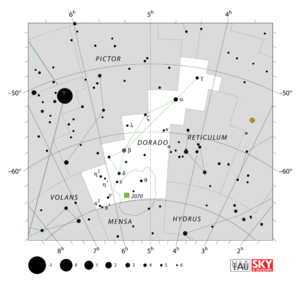Dorado
one of the 88 official constellations. There is no need to translate the term because "Dorado" already is a modern (not Latin) word and used in many languages to designate a specific sort of fish. For further explanation, "Dorado, the Dolphinfish" would work in English. The Spanish term "dorado" literally means "golden", and it has been used for various type of fish in the past. Given this translation, the constellation name has sometimes been translated as "Goldfish", although the Spanish term always designated exotic fish species from the "new worlds".
Etymology and History
Dorado, the Dolphinfish, has been invented by Pieter Keyser and Frederik de Houtman on their journey to Indonesia (later called "Dutch Indies") 1592-1594. Their catalogue of southern stars was published by de Houtman in 1603 as an appendix to a dictionary of the Malaysian (and other) language(s). Before the publication of the star catalogue, de Houtman shared his data with Petrus Plancius, who had actually commissioned this work. Even in the 1590s, Plancius had worked with this material and his celestial globe of 1598 already displayed paintings of the newly invented constellations in the south, and so did Johann Bayer's Uranometria (1603).
Species of Fish
Despite translating the Spanish term "dorado" (golden), historical Spanish and other European languages never designated any species of goldfish (small freshwater pet fish) with the term.
In biology, "Dorado" is the name of two sorts of fish: a freshwater fish in South America and a predatory fish that lives in the ocean. The ocean inhabitants, who had inspired de Houtman and Keyser, are today known as dolphinfishes with the scientific genus name "Coryphaena". The "Common Dolphinfish" (Coryphaena hippurus) is called Mahi Mahi, the Hawaiian language term for "very strong". In Persian, the word "mahi" (ماهی) happens to mean "fish" which is unrelated to the Hawaiian term. Although there are other names for the fish in some regions (e.g. "Lampuka" on the Mediterranean island of Malta and specifically "Ikan Lemadang" in Indonesia, where de Houtman and Keyser invented the celestial name), the Hawaiian term became publicly known. To avoid confusion with dolphins (the sea mammals that are unrelated to all species of fish), the term for the fish that is used in the public, e.g. in restaurants, is Mahi Mahi.
Modern transformations
The standard topic that Dorado hunts Volans can be traced throughout history. Yet, Bode and Goldbach show some anomalies: Bode wrote two books: one in German in 1772 as a very young man, training himself in astronomy ("Anleitung zur Kenntniß des gestirnten Himmels") and his famous atlas as senior astronomer at the Berlin observatory, Uranographia (1801). In 1772, he labels Dorado "swordfish" and in his Latin-labelled atlas consequently "Xiphias" (and not "Dorado" like everybody else). Goldbach (1799) reproduces Lacaille's map but labels it in German with the translation "swordfish" while in his own interpretation of the map (next page), he labels Dorado "goldfish".
IAU Star Name Discussion
As the stars of Dorado are rather faint, no one of them has a historical proper name. The main star is α Dor (3.3 mag) and β Dor has 3.8 mag; all other stars are fainter than 4 mag.
As the official translation of the constellation name should be "Dolphinfish", it might be an idea to name the brightest star (α Dor) Mahi Mahi but we need to make sure that this does not cause conflict with the Hawaiian native speakers and their culture.
Ruggles et al. Austronesian star catalogue in NIH3 mentions the dolphin constellations "Kailou" from the Admiralty Is. [Parkinson 1907: 378; Kötz 1911: 52] and the Kankanaey language term "Sipat" [Ambrosio 2010]. Both are identified with modern "Delphinus" or Dorado. In other words, Dorado could possibly be known as Kailou in Melanesia and Sipat in the Malay Archipelago, both of which suggest to me that Keyser and de Houtman might have named the constellation Dorado because it already had that name in the native tongue(s). This leads to the suggestion of Kailou and/ or Sipat for stars in Dorado.
Ambrosio (2010, 155): "Sipat and Tudong are mentioned in prayers for the offering of a chicken for someone who cannot control urination, and for the ceremony of kentan, where the rice seedlings are blessed before being planted." The primary source (Morice Vanoverbergh, Kankenay Religion, Anthropos 67 (1972), 91) identifies Sipat as "The Dolphin" whereas Tudong is "part of Andromeda, Pisces, Triangulum, and Aries". It is pretty clear that the Dolphin in question is Delphinus, not Dorado. "Sipat" in Tagalog does not mean Dolphin but rather "look carefully". It may have other meanings in other Filipino languages that we don't know, but we will rule out this term for stars in Dorado.
Kailou is certainly a fish name in the Manus (see Akimichi and Sukiyama 2010, doi.org/10.15021/00004269, cf also Doina Bucur https://arxiv.org/pdf/2306.17573v3, p7). Unfortunately it is the wrong type of fish (jack [Carangidae]), and, once again, the name is more likely to apply to Delphinus rather than Dorado.
The name Mahi Mahi was never to our knowledge applied to an asterism, so I remain uncomfortable using this Hawaiian term. The Indonesian term "Ikan Lemadang" is a bit of a mouthful, and not internationally recognised, but it may possibly be more appropriate. If we apply "Kailou" here, we probably apply it to the wrong region in the sky.
References
- Ian Ridpath, Star Tales. website
- Frederik de Houtman (1603) Star Catalogue concerning the Indian Magpie
- Alfred Maass, ``Sternkunde und Sterndeuterei im malaiischen Archipel'', Tijdschrift voor Indische Taal-, Land- en Volkenkunde, vol. 64 (1924), pp. 1-172 & 347-459, with a "Nachtrag", vol. 66 (1926), pp. 618-670.














